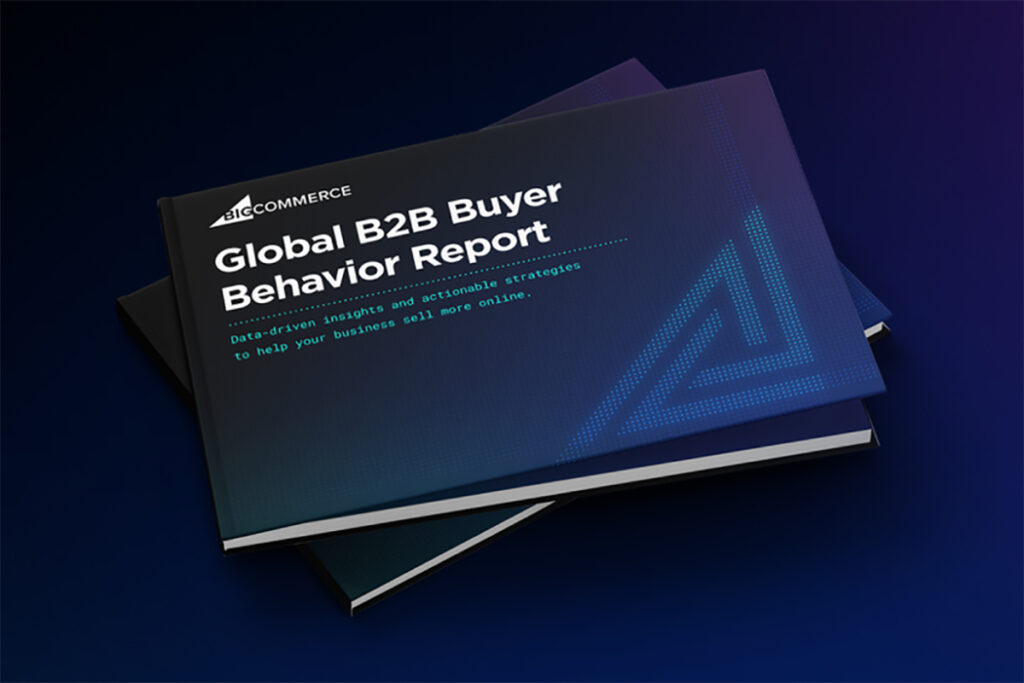BigCommerce have released the results of their latest Global B2B Buyer Behaviour Report examining the changing habits and preferences of B2B buyers in the US, UK and Australia.
The results reflect a continued blurring of lines between consumer retail and B2B ecommerce trends. B2B buyers increasingly expect the same experience they get as consumers: engaging mobile responsive sites, product and pricing transparency and a frictionless checkout experience.
The findings also mark a call to action for businesses to modernize their ecommerce operations or risk being left behind at a time when B2B ecommerce is still relatively young. According to eMarketer, ecommerce is the fastest-growing channel for B2B product sales, and US B2B ecommerce sales will exceed $2 trillion by 2024.
The way B2B buyers shop is changing, and B2B merchants need to adapt. Buyers are turning to online channels to research, compare and purchase products. B2B merchants need to have a strong online presence and offer a seamless omnichannel shopping experience to keep buyers loyal and converting — or risk losing market share.
– Lance Owide, general manager of B2B at BigCommerce
BigCommerce survey key findings
- 74% of respondents said they use online platforms to purchase products
- 65% said they use search engines as the main means of product discovery, while 42% cited online marketplaces (such as Amazon Business)
- 60% of respondents shared that they use B2B marketplaces to make purchases, with 51% of those using Amazon Business
- B2B buyers’ main pain points during the purchasing process are inaccurate pricing and shipping costs (40%), slow website load times (29%) and poor customer support (28%)
- 31% of respondents indicated that technical issues kept them from completing an online purchase
- Respondents indicated that the most important feature of the checkout process was not mobile support or auto-renew functionality, but displaying complete and accurate pricing information
How B2B buyers discover and purchase products
While digital platforms like internet search results and online marketplaces prove to be the most frequently used ways that buyers find products online, 42% of global respondents discover products for their business from catalogs, signaling that catalogs are still a viable way of grabbing buyers’ attention. Meanwhile, just 24% of global respondents said they discover new products at trade shows as live events are still ramping up globally after coming to an almost complete halt during the Covid-19 pandemic.
The pandemic sparked a rush to ecommerce for B2B merchants and buyers as in-person interactions shut down. A 2021 survey by Sana Commerce found 87% of B2B buyers identified new suppliers online, up from 78% prior to the pandemic. Using websites to evaluate suppliers increased as well, with 74% of B2B buyers doing so in 2021, compared to 60% before Covid.
Among the most used purchasing channels, suppliers’ ecommerce websites and apps were the most selected across the US (75%), UK (73%) and Australia (77%). B2B marketplaces and in-store/warehouse purchasing followed close behind. Interestingly, buyers in Australia purchase significantly less through B2B marketplaces (45%) than their counterparts in the US (65%) and UK (62%).
Of merchants in the BigCommerce survey who had purchased on an online marketplace, 51% of those respondents selected Amazon Business, with Walmart (23%) and Alibaba (19%) seeing significantly fewer selections. Broken down by region, there are significant differences in which marketplace buyers prefer. Buyers in Australia utilize Amazon Business (38%) less than the US (57%) and UK (58%).
Ratings and reviews and peer recommendations are major drivers when it comes to making the decision to purchase. Promotions and marketing also ranked highly, signaling the importance of strong B2B marketing campaigns. Trade events lagged behind as events are still ramping up globally after the pandemic.
What B2B buyers want from ecommerce sites
B2B buyers value the option to buy online because of benefits such as the ability to compare products and prices across competitors, customize their orders, save their purchase histories and make purchases at any time from anywhere. However, those benefits are negated when websites include inaccurate pricing or shipping options, slow page loads and complicated checkouts.
Inaccurate pricing and shipping costs were deemed most frustrating by respondents (40%). This is a valuable takeaway for merchants who may unintentionally hide shipping costs or taxes until the final stages of checkout. Slow website loading time was ranked as the second-highest pain point for B2B buyers (29%), with customer support challenges (28%) following close behind.
In aggregate, B2B buyers indicated that the most important features for their online purchasing experience were detailed product information and custom pricing and discounts.
Looking at the results based on respondents’ frequency of purchase, however, shows that detailed product information has an increasing importance as frequency of purchases decreases, perhaps indicating that buyers who make fewer purchases want to have more information to make a decision when they are ready. As frequency of purchase increases, however, B2B buyers display more preference for bulk ordering than those who purchase less often.
B2B sellers need to get the basics of a website right before moving on to bigger and better functionality. Many of these basic functions come from their experiences in the consumer retail space, mobile responsive sites and customer reviews to name a few. Technology partners can help alleviate some of these stresses. Customer service, for example, could benefit from implementing a live chat function, allowing buyers to speak directly to a representative from the site.
– Lance Owide, general manager of B2B at BigCommerce
What B2B buyers expect during checkout
The checkout process is a critical step in ecommerce because even the slightest bit of friction can cause buyers to abandon their carts. Respondents in this section were asked about how they paid for products, as well as the pain points they experience during the process, and how those pain points can impact their final purchase.
Surpassing all other selections by a fairly wide margin, the top reason B2B buyers abandoned their carts was because of technical issues faced at checkout (31%). This, along with a complicated checkout process (15%), signal the importance of a smooth, effortless checkout experience. Lack of secure checkout was the second biggest reason for abandoned carts across all regions, but it was the No. 1 reason in the UK with 30% of respondents choosing it, compared to 20% in the US and 21% in Australia.
Credit and debit cards are the most-used payment methods across regions with more traditional B2B payment methods such as automated clearing house (ACH) and purchase order (PO) invoicing following closely. Electronic and physical checks were significantly more preferred in the US over the UK and Australia.
When it comes to preferred checkout features, respondents overwhelmingly value total and accurate pricing information, followed by the availability of multiple shipping options.
While not showing high preference overall, respondents who have to go through 10 or more approvals showed some preference for an auto-save cart feature, signaling the importance of this function to buyers who have longer purchasing processes or will need to come back to their cart later during the approval process. Similarly, auto-renew or subscribe-and-save options showed increased preference from respondents with higher approval levels as well.
B2B buying habits have been through a tremendous transformation over the last few years, and BigCommerce’s platform makes it easy for merchants to meet those buyer expectations. Whether purchasing from suppliers, manufacturers, distributors or wholesalers, buyers are no longer relying solely on sales teams to guide their purchases. Instead, the journey has become a mix of physical and digital interactions that often results in a final purchase online.
– Lance Owide, general manager of B2B at BigCommerce









